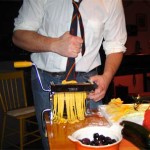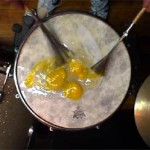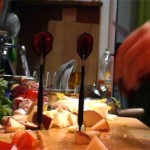By JENNIFER MCMACKON
Much is said in our time about the intersection of art with public space and the idea of the art gallery that exceeds the limitations of it’s walls. But for Patrick Macaulay, Visual Arts Curator at Harbourfront's York Quay Centre it’s just another day in the life of an institution mandated to make art do just that. Working with a seasonally changing umbrella of themes shared by all of the centre'svarious organizations, Macaulay is consistently innovative, proactively looking to his community to ensure every nook and cranny under his jurisdiction buzz and sparkle with works of contemporary visual art.
The Cooked Book, Dean Baldwin’s eight channel, asynchronous video presentation (made especially for Harbourfront in tandem with Toronto’s annual Images Festival ) exemplifies Macaulay’s programming acuity. Baldwin’s piece transforms a stroll along the path between the theatre and the gallery into an encounter with what the press release for his exhibition calls “…conglomerate chapters of a dysfunctional whole – part cooking show, part obstacle course, where the process of a meal preparation is continually sabotaged by external tensions”. Housed within a row of eight, square, eye level vitrines, it unfolds a kooky, private series of adventures withfood in a space that would otherwise be an absolutely banal corridor.
Baldwin’s videos produce no volume so the coloured light emanating from each piece is accentuated, filling the hall with the promising, magical glow of T.V. Land. Each vitrine proffers a sneak peek at what seems to be a closed circuit, if not secret cooking channel. Each episode depicts delicious food in a continuous state of mostly unorthodox preparation at the hands of an anonymous (Baldwin himself ?), chef. The signifiers are myriad for anyone who has spent a minute in front of the television lately. T.V. Chefs are a cult of personality twenty-four hours a day. Conjuring whole feasts in just minutes with great ease and élan; such individuals impart all manner of adventurous, glamourous savoir faire to cable junkies, would be home entertainers and the hapless hungry alike.
Though Baldwin’s chef /preparateur’s culinary skills seem dubious, they are also winsomely improvisational. This chef shucks oysters on the car dashboard while casually cruising the side streets of downtown Toronto’s West End. Eggs are beaten on the top of a drum kit. Potatoes are peeled in mid air à la Fragonard’s Swinger - their shorn skins dropping like hailstones onto the playground below. And medallions of sliced baguette await juicy dollops of tomatoey topping while spinning on top of a turntable. The vignettes transform simple acts of readying food for consumption into tragicomic feats that are thwarted in each case by peculiar, built in methodology and suspended in the perpetual play of the video loop.
There is a terrific, sideways sensibility in Baldwin’s work that is simultaneously humourous and touching. In one chapter of hisdysfunctional conglomeration, the camera closes in on the chef’s hands, hard at work dicing wedges of fruit with a sharp knife. The grace and rhythm of his actions are disturbed however, by darts which drop like pointy bombs onto the cutting board from a mysterious source on high. A viewer can’t help but wince for the tender flesh of the chef’s ( nimbly dart avoiding) fingers which becomes at least as vulnerable as the fruit he chops so industriously. This feeling is exacerbated as he casually clears the little daggers out of the way so as to continue his work; it is almost as if he gives them back to a hidden dart bomber, setting the hazardous cycle, the siege of droppings in motion once more. In another tableau, a beefier empathy trigger is set on the floor of a racquetball court . Here, over a small wooden cutting board the same hands pound a bright red steak with a meat mallet . In the background, the feet of the court’s solitary player pummel the floor into oblivious submission – racquet swinging - all the while driving a ball against the wall….
My favourite of The Cooked Book’s offerings is presented with a much lighter touch. It begins with cocktails and smoke rings evocative of Christopher Walken’s character in The Continental skits from Saturday Night Live. In this episode Baldwin’s chef steps behind a pasta maker, enacting a drama of entanglement with his necktie and creating a countertop landscape featuring great hunks of lumpen pasta dough. Baldwin articulates all kinds of fraught desires with great economy. This work provokes in me a fleeting association with certain cooking scenes in Kuchar’s Weather Diaries commingled with a judicious sprinkle of old time television slapstick – remember Lucille Ball in the chocolate factory? This piece is ripe with loaded yearning and a delightful, ironic sense of humour.
It is great to see fresh, challenging new video work made specifically for a venue with a wide open public audience and in collaboration with The Images Festival. Macaulay’s habit of exhibiting consistently experimental work - thoughtfully and proactively culled from Toronto’s art community is absolutely commendable.
- Dean Baldwin, The Cooked Book, video stills from the 8-channel DVD installation, 2007.
"The Cooked Book" is on view March 17- May 13, 2007 in The Cases at Harbourfront’s Queen’s Quay Gallery.
All images are courtesy of the artist.







